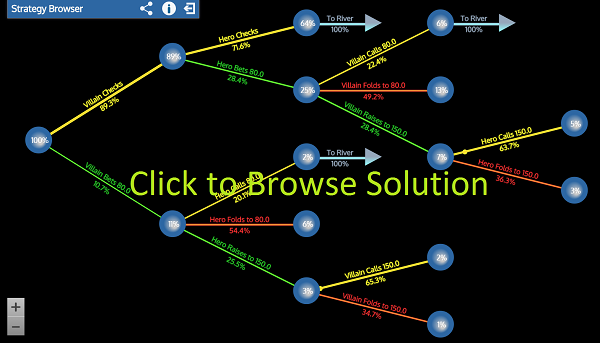Today I'm going to give a simple example of how to use GTO poker and GTORangeBuilder to directly improve your play in a common real world situation that many players struggle with and show the general analytic process that I use in my strategy packs. For the actual analysis I decided a video demo would be the most instructive, see below. You can browse the solution that is discussed in the video here:
however before getting into the video I always wanted to take a second to answer three common questions that I often get from people who are new to computational GTO analysis.
- Why should I study GTO, doesn't GTO play just break even against fishy players? Don't I need to focus on exploiting the fish I play against?
- GTO play most definitely does not break even against fishy players, in general it crushes them. The idea that GTO is a purely defensive or "break even" strategy is a misconception that comes from people often learning about it in very simple "toy game" situations like rock paper scissors or the clairvoyance game. In real world poker situations GTO play extracts significant EV from both regs and fish, see here and here for more details. GTO theory also lets us target specific leaks using a concept called minimally exploitative play and GTORB lets you lock in specific opponent strategies that you wish to minimally exploit.
- Isn't GTO play just about understanding 1-alpha bluffing and calling frequencies? Why do I need computational solutions?
- Before true computational GTO solvers like GTORB emerged, many players tried to "estimate" GTO play using the 1-alpha value derived from the clairvoyance game in the mathematics of poker which assumes one player has a purely nuts or air range and the other player can only possibly hold bluff catchers. It turns out that once we had software that would let us actually calculate true GTO play in specific situations it become clear that these estimations were far from correct and missed many of the key strategic intricacies that exist in poker. In the flop c-bet defense strategy pack I showed that defending vs flop c-bets at a 1-alpha frequency is usually a major mistake and in my Cardrunner's series I show that even in very simple river situations some of the best 1-alpha based ranges like those from Matt Janda's books are many times less accurate than computational solutions and can misplay key hands.
- GTO strategies are so complex that I could never hope to correctly play them at the tables, how can I actually learn anything that is useful to my everyday play from GTO solutions
- As I show in the video below, the goal of studying GTO play is not to try and directly copy the exact frequencies in your own play at the tables, but it is instead to gain a deeper understanding of the fundamental elements of strong poker strategy in specific types of situations. In the video below I demonstrate how you can scientifically and precisely measure the EV importance of strategic options like donk-betting the turn, using different bet-sizings, etc to gain a deep understanding of the a complex real world poker situation.

No comments:
Post a Comment
Note: Only a member of this blog may post a comment.